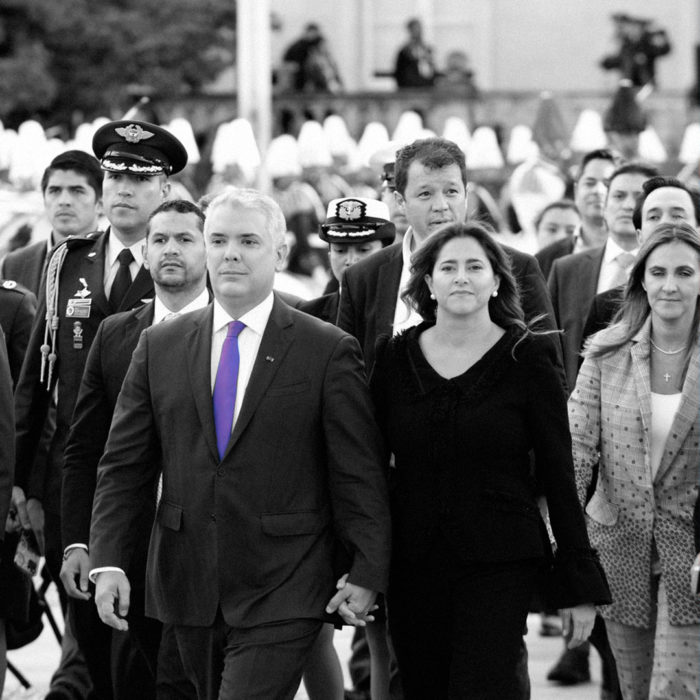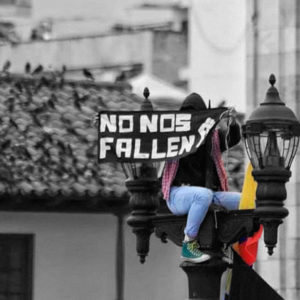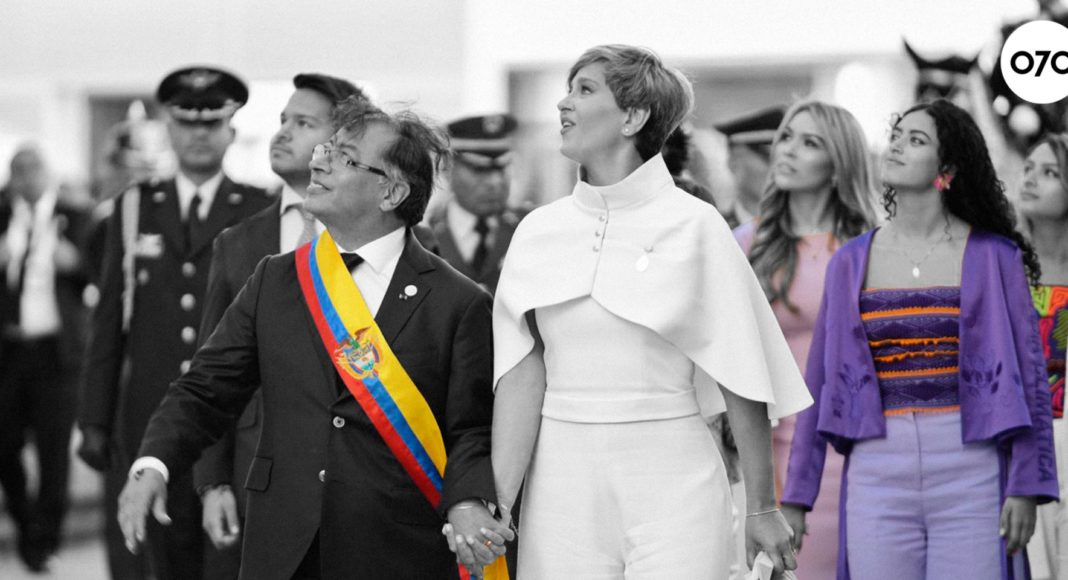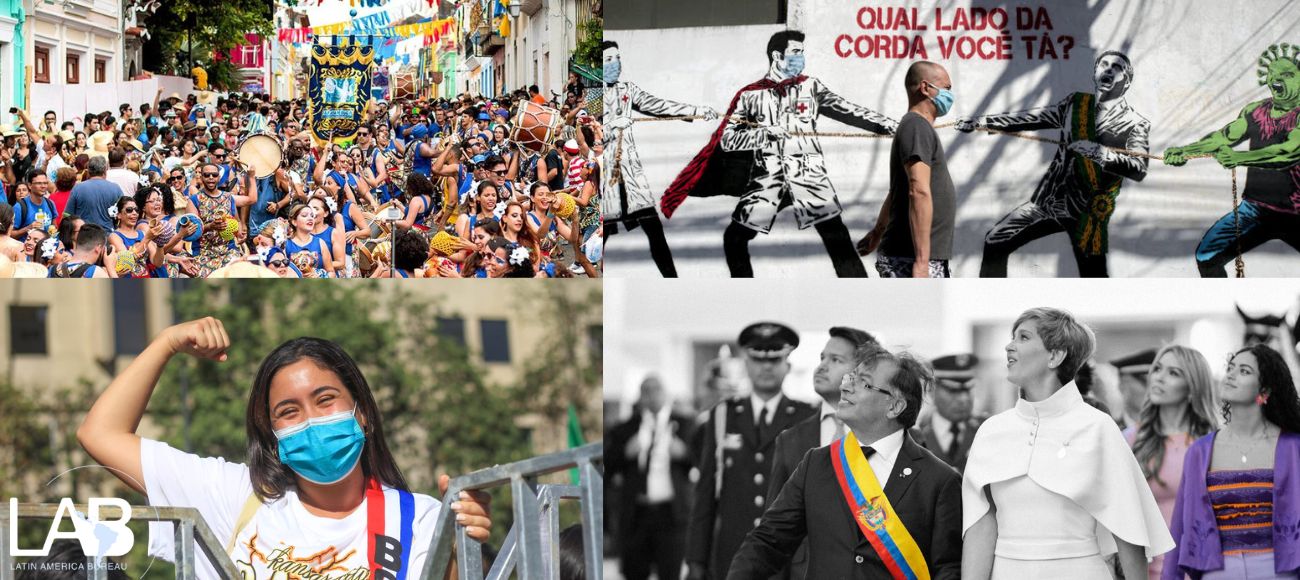Unlike last time, Colombia’s presidential inauguration last month didn’t feature a red carpet. President Petro’s speech was marked by emotion and the resignification of traditional symbols. For Cerosetenta, three experts analysed the aesthetics of the inauguration ceremony. Liam Casey translated this triptych of articles for LAB, marking a month since Gustavo Petro’s inauguration.
Almost everything was different, even the weather: there was neither the wind of four years ago, nor the rain that in 2018 drenched the gathered luminaries and gave us the indelible image of a first lady sheltering under the umbrella held by a police officer –a lasting image of the forever elites.
This time there was no red carpet. President Gustavo Petro’s speech was marked by emotion and by the resignification of the usual symbols and protagonists. The Indigenous Guard cleared the way of honor for the new president; together with the Colombian flag, the Cric flag, the Onic flag and the Misak, Nasa and LGBTIQ+ flags. Simon Bolivar’s sword, which the new president ordered to be brought to the ceremony as his first act of government, also played a central role.
And, as Ricardo Silva wrote, the most repeated word in Petro’s speech was ‘hopefully’: hopefully we can make the change that the country has been waiting, hopefully security can be defined by life and not by death, hopefully the war on drugs will finally end, hopefully peace can be achieved.
Downtown Bogota, normally closed for presidential inaugurations, was instead open and ready to receive the crowds with cultural events and screens to broadcast the event to all in attendance. Traditional inauguration protocols were upended by a public that between chanting, crying, and even booing, accompanied Gustavo Petro as he took office as President of Colombia.
The event was full of disruptive symbols wrapped in a new aesthetic. For this reason, Cerosetenta asked three experts who work in fashion, communication, and image analysis to write a reflection on what they saw, how they analysed the change of government and what the images Colombia saw during the inauguration say about Petro. These are their reflections…
From dark to color
By Edward Salazar
It is impossible not to notice the outfits on any occasion made for the display of symbols and ideas, as in the inauguration of the first leftist president of Colombia, Gustavo Petro Urrego.
The symbol that seems to me the most powerful of the inauguration of the first leftist president in Colombia is that of eighteenth-century attire – a symbol of war, power, and masculinity in a time even before the nation: epitomized in the sword that belonged to Simon Bolivar. It was then a regular accessory on the male body, a symbol of power and work, of violence, conquest, and liberation. Today it is kept in a case and marks a memorable episode of dispute between Duque, who did not want to lend it, and Petro, who ordered as his first action in power to have it brought immediately. The sword entered the plaza with great theatricality, transported by mock lead soldiers dressed in anachronistic viceroyalty uniforms that today look more like costumes of an antiquated museum of masculinity.
The act of inauguration comes with a long tradition of black, grey, and blue suits (whose origin is also military) and a ceremony that affirms dark tones as the only acceptable idea of elegance. It is not an aesthetic of decadence, because there is something eternal in black, but also in the white worn by Veronica Alcocer and Maria Clemencia Rodriguez, both in the role of first ladies in governments with prospects for peace. But it is an aesthetic that limits diversity.
At the same time in Plaza Bolivar, the public was adorned with hats of all kinds: peasant hats, indigenous hats –like the Kuarimpete of the Misak ethnic group– in a ceremony that broke the traditions of the Colombian political-economic elite thanks to a minimal premise: that this was an event for the people and not for the old elites.
We saw Sofía Petro wearing a purple jacket –the emblematic color of feminist struggles– designed by Diego Guarnizo, together with master craftswomen Adriana Gómez and María Guzmán using the fabric-on-fabric technique. The scene woven on the jacket represented life in the countryside and on its sleeves, the phrases ‘Social Justice’ and ’Environmental Justice’ were connected to the political premises of Gustavo Petro and Francia Márquez. The jacket reminded me of the tapestries of the weavers of Mampuján that tell stories of violence and peace, a text that allows for the figuring of memory. Sofía Petro wore these messages on a chumbes top made in the Sibundoy Valley, adorned with beads woven by the Emberá-Chami people.
Also from Guarnizo was María José Pizarro’s dress, which on its back featured an appliqué of beads by Juan Heredia and Mateo Perea forming the face of her father Carlos Pizarro, the assassinated leader of the M-19.
Francia Márquez wore a dress by Esteban Sinisterra, which perhaps did not cause too much surprise because she was already accustomed to expressing her aesthetic-political agenda through fashion. Her golden earrings embodying the map of Colombia are already a Francia hallmark, surely one that’s shared by the thousands of women dreaming by her side.
David Racero, President of the House of Representatives, wore a beautifully tailored suit designed by Nia Murillo from Chocó, which revealed an indigenous fabric that stood out amidst men dressed in such traditionally masculine fashion.
The display of these political textiles culminated with one of the day’s most striking images: while Petro and the new presidential family entered the Casa de Nariño in purples, blues, and whites, Duque and his family came out with a predominant black palette. This image signified the change of government as a change from dark to color.

But beyond fashion, the interesting thing to note about Petro’s inauguration was the transformation of ideas of taste, diversity, elegance, and power displayed by these dressed bodies. It also shows that in Colombia, the fashion universe is no longer made up only by renowned designers, but by individualized artisanal traditions.
Co-creation is the language of the future.
In the political world, fashion has gradually become a playful and communicative strategy to make a point in the face of power. Fashion does not solve the needs of a helpless society; indeed, fashion can even be a disguise to distract from urgent need. But the truth is that on Sunday, August 7, fashion gave us a small glimmer of confidence. Costumes can be a symbol of hope in a country that changes its forms of government and that, thanks to the new aspirations of fashion and culture, leaves aside its inclinations for military aesthetics and forms.
Colombia’s fairs and festivals
By Omar Rincón
A new president arrived and there was a party: the fairs and parties of democracy that Colombia has long deserved. This time they were possible because the people –those who dance and sing and move to express themselves, those who laugh, narrate and hope in spite of all the tears– feel that at last someone like them has arrived, someone who is like us Colombians: more Indigenous, more Afro, more ‘of the people’.
These people do not speak in solemn speeches like the elite of Bogota (almost all of the 20th-century presidents and Santos), or like the paisa elite (the prayers and farms of Uribe and Duque). Now comes the commotion, the colour, the bodies… and the party begins. This is democracy: when we all dance and, by dancing, we become collective. There is a new class, a new elite in government.
Everything is summed up in this image:
The new president in his official image looks like a popular fool in kitsch: there’s color, nature, a typical Colombian pastiche in the background. This is how people take their picture when they can’t travel the world. There’s more color, more music, more bodies, more joy… strange that this was democracy, and we didn’t know it yet.
Between officialdom and transgression, a new sign: political hope
By Carolina Charry Quintero
What we saw in the official presidential inauguration –both in the handover of power with the Indigenous communities and on the ‘official’ day of electoral victory of Petro and Francia Marquez– was unprecedented event in the history of Colombia. Something which burst and ruptured the course of events that, until now, were endlessly repeated without change. The philosopher Hannah Arendt points out that the human condition is defined by its birth. That is, by its capacity to be born and create new beginnings. And so the human world, the political world, Arendt says, is the world where the unforeseeable can happen. What we saw, what we are seeing, is precisely that which was not believed to be possible, that which many had predicted to be impossible: the new.
And what is it that we saw? We saw something which for a long time seemed incompatible and unattainable: the left invested with official power. We saw the meeting of official symbols with transgressive, popular, and marginal symbols.
We saw the meeting of official symbols with transgressive, popular, and marginal symbols.
We saw the official symbols of the status quo, those we have learned to identify with oppression, with deceit, with exclusion, with trickery, with rampant violence and, in short, with injustice: among them the flag, the coat of arms, the presidential sash, the Palacio de Nariño, the inauguration choreography, the cadets’ walk. And it is true that these symbols correspond to the story of the homeland, to the militaristic story of the State. This story has been imposed for centuries by attacking and ignoring cultures, not only perpetuating but also producing inequality. And here these symbols appear again, this time to empower those who embody the struggle against this history of inequality and oppression.
This presidential inauguration was not the only ceremony. It was preceded by two others with Indigenous communities. That is to say that the new government recognizes not only the official state institution, but also unofficial expressions of authority. These acts destabilize the traditional narrative of the State and legitimize what has been historically excluded.
The protocol of the official inauguration was accompanied by a collective popular celebration. There were other symbols. There were other costumes, there were diverse bodies together, there were sounds of indigenous instruments, there was traditional music, the music that carries our history: Caribbean music, Pacific music, marimbas, bagpipes, drums. Afro history and culture were present. There were standing bodies, dancing bodies; vociferous, active. This is not just a crowd. It is heterogeneous. Far from being submissive, it is a thinking, acting crowd. It is a multitude that, at the same time as it celebrates and offers up a mandate, also expects and demands responsibility. Those bodies in the public square, in the streets, now recognize themselves as political subjects. Subjects who have ceased to consider that things cannot be different; they no longer abstain or resign themselves, but participate and act.
It is not, therefore, a credulous or idealizing multitude. This is not the moment we are living in Colombia. There is no populism here as some would like to claim. The people in the square and in the streets are the political event of these times. Citizens no longer feel powerless. What we saw in the social outburst, in the elections and in the inauguration ceremonies, is a citizenry that has reached a moment of political maturity and recognizes its own power. Power is seen here as Hannah Arendt conceived it; that is, as the capacity to act in concert. The unforeseeable could happen, what was once considered impossible or radically distant was rendered in the collective chorus as ‘Sí se pudo’ (Yes we could!). Joy and popular celebration become a form of political participation.
We thus see an unprecedented meeting of official and popular, official and transgressor symbols, and this is what configures a new symbol. This new expression is the result of all that Francia Márquez has built, who in her pronouncements and actions has insisted on the importance of those who have been systematically excluded by the State. The seemingly paradoxical coexistence of the official and the transgressor is what configures the new symbol.
This is also the case with Petro’s ‘order’ for Bolivar’s sword: it was both an official exercise of authority and an act of transgression, an act that gives historical importance to the M-19 armed group’s robbery of the sword from the Palace of Justice in 1974 and turns it into a promise of change.
A gesture to history is not the same as a military promise. Despite all the phallic symbols that constitute weapons (all of which were present at the inauguration), the military is not the preponderant thing here. There is no militaristic tone or threat. This absence is characteristic of the new government and the political phenomenon at large.

To see Petro with the presidential sash, with the official signs of the government, to see him with the Arhuac community, all this is part of the new expression. A young man with a hood over his face climbed a light pole holding a banner that read ‘Don’t fail us.’ It was people like him, those participants in the social protests, who made this political phenomenon possible.
Presidential inaugurations traditionally seek a display of power that takes the form of the deployment of coercive forces, i.e. military force, precisely because power is equated with violent capacity. But here again, Hannah Arendt points out that power and violence are inversely proportional. The greater the power, the greater the capacity to act in concert, the less need for violence and vice versa. The tyrant, Arendt said, is alone and is therefore violent and impotent. In the inauguration of Gustavo Petro and Francia Márquez, we witnessed a display of power in the form of a demonstration of legitimacy. That is to say, a multitudinous and multicultural display of legitimacy and popular recognition throughout the country. This is evidence not of the coercive capacity of the new government, but of its authentic political power.
What we saw and are seeing is joy as a collective political experience, a joy that comes from a deep pain formed over centuries. Here, in the country where for too long we have wondered, unanswered, what does it look like, what form does it take, what would it be like to have hope? Well, this is how it looks, this is how it sounds, this is how it speaks, this is how it dances: imperfect, strange, eclectic. This is how political hope operates.


